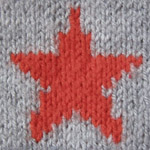UNDER CONSTRUCTION - Menu links may be unreliable for a short period.
Sequence Stripes
Usually knitted stripes are evenly sized or arranged in a short repeating pattern. Sometimes they may even be that old favourite, exactly-how-much-of-that-colour-I-have-left sized.
If you are looking for something a bit different there are many different mathematical series that can be used as inspiration. The following patterns are knitted by matching the row count to the numbers in the sequence.
Arithmetic Sequence
(e.g. 2, 4, 6, 8, 10, 12, 14...)

In an arithmetic sequence the difference between one number and the next is always the same. In this example each value in the sequence is equal to the previous value + 2.
Collatz / Hailstone Sequence
(e.g. 3, 10, 5, 16, 8, 4, 2, 1, 4, 2, 1...)

Start with any positive, whole number. If it is even, divide by 2. If it is odd, multiply by 3 and add 1. Do the same to the result.
For all the initial values tested so far (and they've tested up to about 5.48 x 1018) the sequence eventually becomes 4, 2, 1 repeating. The interesting thing is no one has been able to prove if it's going to be true for all numbers. It's an unsolved problem.
Fibonacci Sequence
(1, 1, 2, 3, 5, 8, 13, 21...)

In the Fibonacci Sequence each number is the sum of the previous two values. This sequence is found a lot in nature.
Figurate Number Sequence
(e.g. 1, 3, 6, 10, 15, 21...)

An example of a Figurate Number Sequence is the Triangular Number Sequence. Each number is the sum of the previous value and the current position in the sequence (e.g. the 5th triangular number is 10 + 5)
The easiest way to work out the values is by drawing triangles of dots with the length of the base increasing by one each time...

Golomb Sequence
(1, 2, 2, 3, 3, 4, 4, 4, 5, 5, 5...)

In the Golomb Sequence the value of n matches the number of numbers in the nth run of numbers.
Yes, I realise that was clear as mud.
Looking at the above sequence there is:
1 number one, followed by
2 number twos, followed by
2 number threes, followed by
3 number fours, followed by
3 number fives, followed by
Looking at the bold numbers you can see how the sequence emerges.
Juggler Sequence
(e.g. 5, 11, 36, 6, 2, 1)

Start with any positive, whole number, n.
If n is even the next value is n1/2 rounded to the nearest integer.
If n is odd the next value is n3/2 rounded to the nearest integer.
It's called a Juggler Sequence because for all the initial values tested so far the sequence goes up and falls back down to 1. Like the Collatz / Hailstone Sequence, no one has been able to prove if this will be true for all numbers.
Kolakoski Sequence
(1, 2, 2, 1, 1, 2, 1, 2, 2, 1, 2, 2...)

Like the Collatz / Hailstone Sequence I'm going to tie myself in knots trying to explain this one in words. Basically the nth number in the sequence gives the length of the nth run. In the above run of numbers there is:
1 number one
2 number twos
2 number ones
1 number two
1 number one
2 number twos
1 number one
2 number twos...
The numbers in bold give the original sequence.
Prime Number Sequence
(2, 3, 5, 7, 11, 13, 17...)

Prime numbers only divide by themselves and one. Writing down prime numbers chronologically gives the prime number sequence.
Random Sequence
(e.g. 3, 4, 1, 5, 5, 4, 3, 2...)

There are all sorts of ways to achieve a random* width stripe sequence with two colours. Flip a coin at the start of every row to decide which colour it will be, use a Random Integer Generator to give stripe widths, or do what I did and roll a die.
*within set parameters
<<< See more Stripe Design Ideas.
© 2010 - 2014 All desgins and images are copyright of ODDknit. If you enjoy the content of this website, please consider buying me a coffee at the link below.


